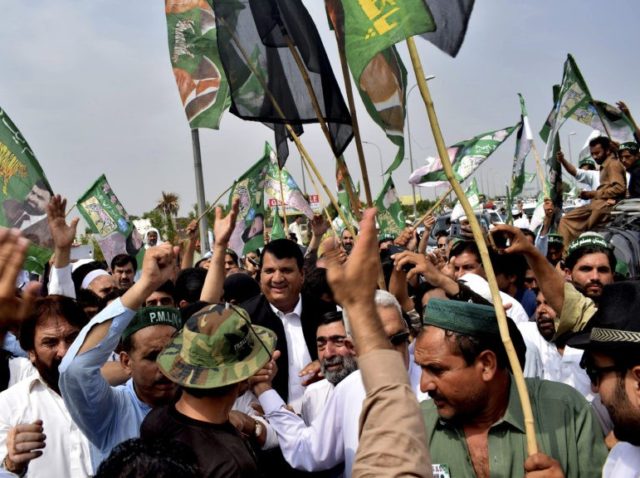This morning’s key headlines from GenerationalDynamics.com
- Second largest terror attack in Pakistan’s history occurs at election rally
- ‘Ghazi Force’ takes credit for attack on 11th anniversary of Red Mosque siege
Second largest terror attack in Pakistan’s history occurs at election rally

Facebook picture of Siraj Raisani, Baloch leader who was killed in terrorist attack on Friday
About 149 people were killed, including nine children, and hundreds injured at a terror attack on Friday in Mastung, near Quetta, the capital of the Balochistan province in southwest Pakistan. This was the second worst terror attack in Pakistan’s history, and it occurs as a nationwide general election approaches on July 25.
The attack targeted an election rally for the Balochistan Awami Party (BAP). Among the 149 killed were the BAP candidate and Baloch leader Siraj Raisani.
The worst occurred in 2014, when Tehrik-e-Taliban (TTP, Pakistan Taliban) attacked an army school in Peshawar in northwest Pakistan on Tuesday, killing 141 people, 132 of them schoolchildren, most of them children of soldiers. ( “17-Dec-14 World View — Pakistan Taliban crosses a red line with mass slaughter of army children”) The 2014 attack was such a shock to Pakistan, especially to the army, that the army immediately began a long-term counter-terrorism operation directed at TTP.
The new attack may not have the same effect of shock as the 2014 attack because of a confluence of events. In the hours after the suicide attack occurred on Friday, the country was riveted by a scene going on at the other end of the country – the return of the charismatic former prime minister Nawaz Sharif from self-imposed exile in London. Beginning in 1990, Sharif has been prime minister of Pakistan for three non-consecutive terms. But Sharif was charged with corruption early in 2017 because of revelations in the leaked Panama Papers, and he left the country after being forced to step down by the Pakistani Supreme Court. Sharif had been promising to return to Pakistan to defend himself against the charges, and on Friday his plane landed and, in the midst of crowds of thousands of supporters, he was arrested and taken off to jail.
So with all that going on, the terror attack in Balochistan did not get much media coverage, and so there was not the level of public outrage and shock that had followed the 2014 terror attack. This is all the more surprising because there were two more terror attacks last week. On Tuesday, a suicide bombing in Peshawar at a rally for the Awami National Party (ANP) killed 21, including candidate Haroon Bilour. On Friday, a bomb roadside bomb killed four people in the northern town of Bannu.
Terrorist violence in Pakistan has ebbed since the military began counter-terrorism operations against the TTP after the 2014 attack. However, with three attacks in the last week alone, and with the election less than two weeks again, Pakistanis are concerned about a new surge in violence. Dawn (Pakistan) and South Asia Terrorism Portal (SATP – India) and Express Tribune (Pakistan) and BBC and Indian Express
‘Ghazi Force’ takes credit for attack on 11th anniversary of Red Mosque siege
The terror group “Ghazi Force Lal Masjid,” linked to Tehrik-e-Taliban (TTP, Pakistan Taliban), claimed credit for the attack. This represents a resurgence of a group linked to a major event that occurred almost exactly eleven years ago.
On July 11, 2007, a spectacular 8-day siege ended after 36 hours in a mosque complex in Islamabad known as the “Red Mosque” or “Lal Masjid.” It had all begun the previous January when dozens of female seminary students studying and living at the madrassas within the mosque complex demanded that the government impose Taliban-style sharia law and arrest the prostitutes in downtown Islamabad. After a while, the female students would come out in black burqas with long bamboo sticks and threaten the prostitutes.
The last straw came when dozens of students kidnapped nine people, including six Chinese women and a Chinese man, leading to protests from China. The result was the siege and bloodbath that ended on July 11. It turned out that the Red Mosque had a huge cache of weapons that apparently had been brought there in the last few months.
The leading cleric for the Red Mosque was Imam Abdul Rashid Ghazi, who called for his own death to spark an Islamic revolution. He said that he would rather be martyred than give in to the government, and he was killed during the siege. Ghazi said that he had declared war against Pakistan’s government for entering into an alliance with the United States following the 9/11 attacks. The standoff left more than 100 militants dead, along with 11 armed forces personnel. It was a significant turning point in terrorism in Pakistan.
Al-Qaeda leaders quickly demanded revenge, and Ghazi’s death has become a global inspiration to other jihadist movements. Six months later, on December 14, 2007, some 40 militant leaders, commanding 40,000 militant fighters, gathered in South Waziristan to form a united front under the banner of Tehrik-i-Taliban Pakistan (TTP).
Now, on the tenth anniversary of the Red Mosque siege, the Ghazi Force Lal Masjid has struck again. Dawn (9-July-2017) and Khaama News (Afghanistan)
Related Articles:
- Pakistan Taliban crosses a red` line with mass slaughter of army children (17-Dec-2014)
- After ‘Pakistan’s 9/11’, war is declared on the Taliban (21-Dec-2014)
- Pakistan: Over 106 dead in spectacular assault on radical mosque in Islamabad (12-Jul-2007)
- Pakistan celebrates its 70th birthday, wondering what Pakistan is (15-Aug-2017)
KEYS: Generational Dynamics, Pakistan, Mastung, Quetta, Balochistan, Balochistan Awami Party, BAP, Siraj Raisani, Tehrik-e-Taliban, TTP, Pakistan Taliban, Peshawar, Nawaz Sharif, Awami National Party, ANP, Haroon Bilour, Bannu, Ghazi Force Lal Masjid, Lal Masjid, Red Mosque, Abdul Rashid Ghazi
Permanent web link to this article
Receive daily World View columns by e-mail

COMMENTS
Please let us know if you're having issues with commenting.